|
|
|
|
|
Galleria Tassonomica
di
Natura Mediterraneo
|
|
|
| Autore |
 Discussione Discussione  |
|
|
Cmb
Moderatore
    
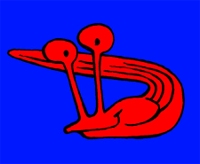
Città: Buers
Prov.: Estero
Regione: Austria

12844 Messaggi
Flora e Fauna |
|
|
Cmb
Moderatore
    

Città: Buers
Prov.: Estero
Regione: Austria

12844 Messaggi
Flora e Fauna |
 Inserito il - 11 novembre 2012 : 10:41:05 Inserito il - 11 novembre 2012 : 10:41:05


|
Siti online
Agostino Letardi - un libro aperto con un chiave
Letteratura usata
| | Aspöck, H., Aspöck, U. & Hölzel, H. (1980): Die Neuropteren Europas. Band I und II. - Goecke & Evers, Krefeld. |
| | CURTO G. M. & R. A. PANTALEONI (1987): Note sui Myrmeleonidae (Neur. Planipennia) raccolti in oliveti del Salento (Italia meridionale). - Boll. 1st. Ent. «G. Grandi» Univo Bologna, 42: 205-217 |
| | Duelli, P. (1994): Neuroptera from the Mediterranean Islands of Malta. - Entomofauna. 15(12): 124-128. |
| | Giacomino M. (2007): Clé de détermination des Myrmeleontidae de France. - Invertébrés Armoricains, 1 : 29-34. |
| | Lackinger, H. (1973): UNTERSCHIEDE IM VERHALTEN ZWISCHEN LARVEN EINIGER AMEISENLÖWENARTEN EINSCHLIESSLICH DES WURMLÖWEN (VERMILEO VERMILEO) BEIM SANDFALLENBAU. - Zeitschr. Arb.gem. österr. Ent., 24(1/2):66-72. |
| | PLANT C. W. & S. SCHEMBRI (1996): A review of the Neuropteroidea of the Mediterranean islands of Malta, Gozo and Comino (the Maltese Islands) (Neuroptera: Coniopterygidae, Hemerobiidae, Chrysopidae, Myrmeleontidae). - Entomofauna 17(2): 25-36. |
| | Stange L. A. & R. B. Miller (1985): A Generic Review of the Acanthaclisine Antlions Based on Larvae of the (Neuroptera: Myrmeleontidae). - Insecta Mundi, Vol. 1 (1) 29 - 42. |
|
 |
|
|
Cmb
Moderatore
    

Città: Buers
Prov.: Estero
Regione: Austria

12844 Messaggi
Flora e Fauna |
 Inserito il - 11 novembre 2012 : 10:44:07 Inserito il - 11 novembre 2012 : 10:44:07


|
La sistema delle Neuroptera
vedi: A timetree of lacewings (Neuroptera)
La sistema delle Formicaleoni (Myrmeleontidae) in Italia
da Link
Sabbia e sole
Il sviluppo della larva di Euroleon nostras ho visto personalmente in Austria [Bregenz Gebhardsberg] una volta in una gola sotto una roccia che ha protetta la sabbia della pioggia. Un biotpop non tipico per questo gruppo d'insetti. Nel mio giardino ho visto una volta nel 01.VI.2002 Myrmeleon formicarius in volo. Ci era una colonia nel giardino sotto un tetto. Nella provincia di Vorarlberg esiste un inventario Aistleitener & Gruppe (2004).
Lackinger (1973) ha scritto: Per catturare le loro prede, i formicaleoni costruiscono nella sabbia o nella terra fine fosse a forma di imbuto. Questi imbuti possono raggiungere in alcuni casi un diametro di 70 mm e una profondità di 30 mm. Le pareti sono costituite da materiale fine e franoso. Se un piccolo insetto supera il bordo dell'imbuto, scivola assieme alla sabbia nel raggio d'azione delle mandibole del formicaleone.
Aspöck & al. (1980): Centro della distrubuzione in Europa è la zona mediterranea. Si aspetta in somma circa 2000 specie nella nostra pianeta. La ovideposizione è poco notato. La ciffra delle uova non si sa. Ci sono tre fase larvale. La trasformazione in pupa è in un bozzolo con sabbia. Dopo qualche settimane scivola l'imago.
Fertins & Casas (2006) informano su effizienza delle imbuti: "Assessing the architectural optimality of animal constructions is in most cases extremely difficult, but is feasible for antlion larvae, which dig simple pits in sand to catch ants. Slope angle, conicity and the distance between the head and the trap bottom, known as off-centring, were measured using a precise scanning device. Complete attack sequences in the same pits were then quantified, with predation cost related to the number of behavioural items before capture. Off-centring leads to a loss of architectural efficiency that is compensated by complex attack behaviour. Off-centring happened in half of the cases and corresponded to post-construction movements. In the absence of off-centring, the trap is perfectly conical and the angle is significantly smaller than the crater angle, a physical constant of sand that defines the steepest possible slope. Antlions produce efficient traps, with slopes steep enough to guide preys to their mouths without any attack, and shallow enough to avoid the likelihood of avalanches typical of crater angles. The reasons for the paucity of simplest and most efficient traps such as theses in the animal kingdom are discussed."
Hollis & al. (2011) write in their article "Specialized Learning in Antlions (Neuroptera: Myrmeleontidae), Pit-Digging Predators, Shortens Vulnerable Larval Stage": "Unique in the insect world for their extremely sedentary predatory behavior, pit-dwelling larval antlions dig pits, and then sit at the bottom and wait, sometimes for months, for prey to fall inside. This sedentary predation strategy, combined with their seemingly innate ability to detect approaching prey, make antlions unlikely candidates for learning. That is, although scientists have demonstrated that many species of insects possess the capacity to learn, each of these species, which together represent multiple families from every major insect order, utilizes this ability as a means of navigating the environment, using learned cues to guide an active search for food and hosts, or to avoid noxious events. Nonetheless, we demonstrate not only that sedentary antlions can learn, but also, more importantly, that learning provides an important fitness benefit, namely decreasing the time to pupate, a benefit not yet demonstrated in any other species. Compared to a control group in which an environmental cue was presented randomly vis-à-vis daily prey arrival, antlions given the opportunity to associate the cue with prey were able to make more efficient use of prey and pupate significantly sooner, thus shortening their long, highly vulnerable larval stage. Whereas “median survival time,” the point at which half of the animals in each group had pupated, was 46 days for antlions receiving the Learning treatment, that point never was reached in antlions receiving the Random treatment, even by the end of the experiment on Day 70. In addition, we demonstrate a novel manifestation of antlions' learned response to cues predicting prey arrival, behavior that does not match the typical “learning curve” but which is well-adapted to their sedentary predation strategy. Finally, we suggest that what has long appeared to be instinctive predatory behavior is likely to be highly modified and shaped by learning."
Una vita per le Neurotteri: Herbert Hölzel
|
 |
|
|
Cmb
Moderatore
    

Città: Buers
Prov.: Estero
Regione: Austria

12844 Messaggi
Flora e Fauna |
|
|
Cmb
Moderatore
    

Città: Buers
Prov.: Estero
Regione: Austria

12844 Messaggi
Flora e Fauna |
|
|
Cmb
Moderatore
    

Città: Buers
Prov.: Estero
Regione: Austria

12844 Messaggi
Flora e Fauna |
|
|
Cmb
Moderatore
    

Città: Buers
Prov.: Estero
Regione: Austria

12844 Messaggi
Flora e Fauna |
|
|
Cmb
Moderatore
    

Città: Buers
Prov.: Estero
Regione: Austria

12844 Messaggi
Flora e Fauna |
|
|
Cmb
Moderatore
    

Città: Buers
Prov.: Estero
Regione: Austria

12844 Messaggi
Flora e Fauna |
 Inserito il - 11 novembre 2012 : 14:34:58 Inserito il - 11 novembre 2012 : 14:34:58


|
Cueta Navás 1911
Cueta lineosa (Rambur 1842) (S)
Nota di Pantaleoni R. & M. Principi nella checklist: Finora nota in Italia solo di Calabria.
| | Mirmoayedi, A. 2003: Description of the third stage larvae of Cueta lineosa (Rambur, 1942) (Neuroptera, Myrmoleontidae) rearing for the forst time in Iran. - The Kharkov Ent. Soc. Gazette. X(1/2). |
|
 |
|
|
Cmb
Moderatore
    

Città: Buers
Prov.: Estero
Regione: Austria

12844 Messaggi
Flora e Fauna |
 Inserito il - 11 novembre 2012 : 14:49:57 Inserito il - 11 novembre 2012 : 14:49:57


|
Myrmeleon Linné 1767
Myrmeleon formicarius Linné 1767 (N, S, Si, Sa?)
La metamorfosi di questa specie si trova ben documentata qui.
Roberto A. Pantaleoni: è una specie settentrionale che a sud del Po segue il crinale appenninico arrivando all'Etna ma rimanendo sempre in quota. Ed anche se 1000 m slm non sono pochi, nella penisola Salentina non dovrebbe starci. Sia nei Balcani che in Iberia infatti la specie è sostituita a sud da taxa vicini ma diversi, in Italia questo non succede oppure ... non si sa cosa succede esattamente. Proprio per questo le popolazioni costiere e meridionali italiane del gruppo sono estremamente interessanti.
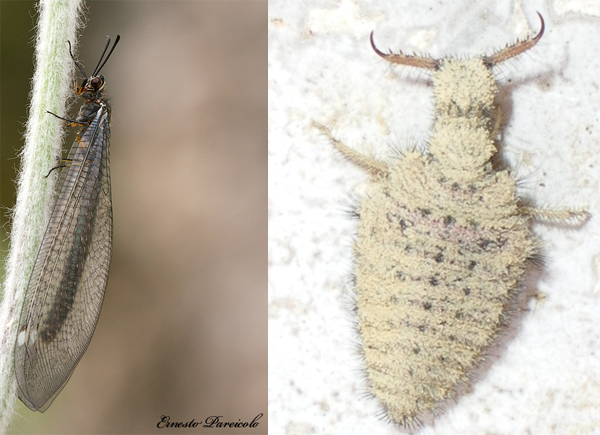
Foto del Imago: Ernesto Patricolo ......... e ................ Foto della larva: Giacomo Giovagnoli
Myrmeleon gerlindae Hölzel 1974 (N, Sa)
Specie della Spagna, Francia mer., Sardenga.
| Hölzel H. (1974): Ein neuer trichterbauender Ameisenlöwe aus Südwesteuropa (Planipennia). - Nachr.bl. bayr. Ent. 23(5): 81-85.
Summary
Myrmeleon gerlindae a new ant-lion found in the Sierra Nevada is described and figured. It can easily be separated from the related M. formicarius and M. noacki by differences in the markings of the prothorax and in all structures of the male genitalia. In addition a short description of the larva is given; some striking characteristics in the shape of the labial palpi and the mandibles are discussed. |
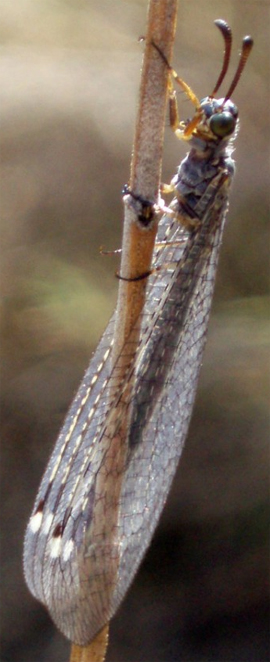
Foto: Isidro Martínez
Myrmeleon punicanus Pantaleoni & Badano 2012 (Si)
Locus typicus:
Pantelleria: Monastero di sopra, (Sicilia, Trapani);
36°46'35.87"N 11°58'57.10"E.
| Pantaleoni R. A. & D. Badano 2012: Myrmeleon punicanus n. sp., a new pit-building antlion (Neuroptera Myrmeleontidae) from Sicily and Pantelleria. - Bulletin of Insectology 65 (1): 139-148, ISSN 1721-8861.
Abstract: A new species of antlion, Myrmeleon punicanus n. sp. (Neuroptera Myrmeleontidae), is described from Sicily and Pantelleria. The new taxon belongs to the formicarius-group thanks to the absence of pilula axillaris in the male hind wings, the characteristics of the male genitalia and the ecological traits. Moreover, the validity of the new species is confirmed by a DNA based phylogenetic reconstruction in which it is compared with closely related taxa. A preliminary description of the third instar larva of M. punicanus n. sp. is also given. Its habitat is the Mediterranean shrub land in which the larvae build pit-traps near shelters. Due to its ecological requirements a possible endangered status cannot be ruled out because of the anthropogenic habitat fragmentation.
|
Myrmeleon mariaemathildae Pantaleoni, Cesarini, Nicoli Aldini 2010
| Pantaleoni R. A. , C. Cesarini, R. Nicoli Aldini 2010: Myrmeleon mariaemathildae n. sp.: a new Mediterranean pit-building antlion (Neuropterida Myrmeleontidae). - Bulletin of Insectology 63 (1): 91-98.
Abstract:
A new Mediterranean species of antlion, Myrmeleon mariaemathildae n. sp., is described on material from Sardinia (Italy) and
Tunisia. The new species, small in size with a relatively pale habitus, can be distinguished from all the other known species of
Myrmeleon in the West Palearctic area on the basis of a set of chromatic characteristics, external morphological features, and the
morphology of the internal male genitalia. The characteristics which differentiate it from Myrmeleon inconspicuus Rambur 1842,
the only other species with which it could be confused, are discussed in detail. A preliminary description of the third instar larva is
also provided. From a bio-ecological point of view, M. mariaemathildae n. sp. is associated with coastal dune environments colonized
almost exclusively by grassy vegetation in which the larvae often build their pits close to Ammophila plants. The new species,
where present, shows a perfect differentiation of its coastal dune habitat with other species: M. inconspicuus and Myrmeleon
hyalinus Olivier 1811 in Sardinia; these and others are being studied in Tunisia. |
|
 |
|
|
Cmb
Moderatore
    

Città: Buers
Prov.: Estero
Regione: Austria

12844 Messaggi
Flora e Fauna |
|
|
Cmb
Moderatore
    

Città: Buers
Prov.: Estero
Regione: Austria

12844 Messaggi
Flora e Fauna |
 Inserito il - 11 novembre 2012 : 17:49:39 Inserito il - 11 novembre 2012 : 17:49:39


|
Euroleon Esben-Petersen 1918
Euroleon nostras (Fourcroy 1785) (N, S, Si)
La specie si trova in tutta Italia. Menzinger-Vracko & Devetak (2008) informano nel suo lavoro "Orientation of the pit-building antlion larva Euroleon (Neuroptera, Myrmeleontidae) to the direction of substrate vibrations caused by prey: Pit-building antlion Euroleon nostras constructs efficient traps in sand to catch its prey. The predator is known to react to substrate vibrations produced by movements of its prey outside the pit with sand-tossing behaviour but it has not yet been ascertained if this reaction is directed towards the prey. The accuracy of the sand-tossing response in the presence of four prey species was measured using a video recording method. The sand-tossing angle was highly positively correlated with the prey angle. Sand tossing was most frequently elicited when prey was on the posterior sand surface. Covering the larval photoreceptors did not influence the antlion's localizing behaviour.
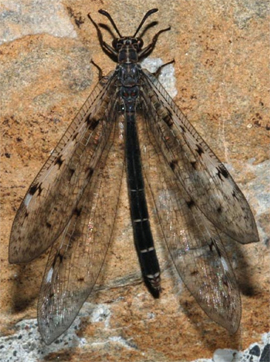
Foto: Giancarlo Medici |
 |
|
|
Cmb
Moderatore
    

Città: Buers
Prov.: Estero
Regione: Austria

12844 Messaggi
Flora e Fauna |
|
|
Cmb
Moderatore
    

Città: Buers
Prov.: Estero
Regione: Austria

12844 Messaggi
Flora e Fauna |
 Inserito il - 12 novembre 2012 : 20:21:20 Inserito il - 12 novembre 2012 : 20:21:20


|
Neuroleon Navás 1909
Neuroleon arenarius (Navás 1904) (S, Si, Sa)
Secondo Plant & Schembri (1996) anche in Malta.
Neuroleon egenus (Navás 1915) (N, S, Sa, Si)
Secondo Plant & Schembri (1996) anche in Malta.
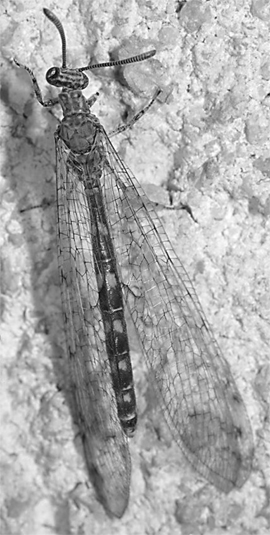
Foto della Sicilia: Luigi Barraco
Neuroleon microstenus (McLachlan 1898) (N, S, Si)
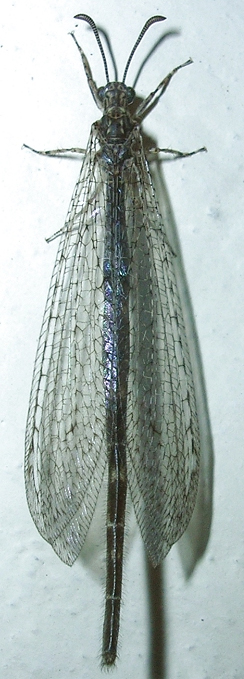
Foto: Maura Bocci
Neuroleon nemausienis (Borkhausen 1791) (N, S, Si, Sa)
Secondo Plant & Schembri (1996) anche in Malta.
Neuroleon ocreatus (Navás 1904) (N, S, Sa)
Roberto A. Pantaleoni: Si tratta infatti della quarta segnalazione di questa specie per l'Italia, dove è nota di Emilia, Toscana e Sardegna.
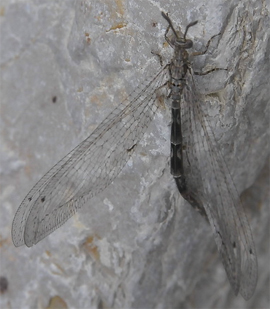
Foto della provincia Siena: Simonetta Peruzzi
|
 |
|
|
Cmb
Moderatore
    

Città: Buers
Prov.: Estero
Regione: Austria

12844 Messaggi
Flora e Fauna |
 Inserito il - 12 novembre 2012 : 21:14:11 Inserito il - 12 novembre 2012 : 21:14:11


|
Distoleon Banks 1910
Agostino Letardi: Roberto/Hemerobius (tasso di affidabilità 99,9% periodico) indicava tra le differenze antenne di una certa lunghezza in Distoleon (laddove Euroleon le ha lunghe in modo meno pronunciato, come solitamente nella maggior parte dei formicaleoni italici). L'addome massiccio può essere una situazione abbastanza variabile per le condizioni ambientali, della foto, etc e non lo userei per distinguere questi due generi di formicaleoni con le ali maculate. Invece la presenza di una bella macchia distale nella parte posteriore delle ali posteriori (scusa il bisticcio) è un ottimo carattere distintivo a favore del genere Distoleon.
Distoleon annulatus (Klug 1834) (Si)
Nota di Pantaleoni R. & M. Principi nella checklist: Nota solo di Vulcano (Isole Egadi), di Pantelleria e di Lampedusa (Isole Pelagie). Secondo Plant & Schembri (1996) anche in Malta.
Agostino Letardi: In realtà non ci sono molte citazioni per l'Italia di questa specie (Pantaleoni, 1990c; Lo Valvo, 1994; Pantaleoni et al., 1995; Bernardi Iori et al., 1995; Letardi & Pantaleoni, 1996; Pantaleoni & Letardi, 1998), da noi sinora rinvenuta solo sulle isole circumsiciliane. Aldini & al. 2012: "... the S Mediterranean antlion Distoleon annulatus (Klug, 1834) is recorded for many small islands".
Distoleon tetragrammicus (Fabricius 1798) (N, S, Si, Sa)

Foto: Franziska Luthi
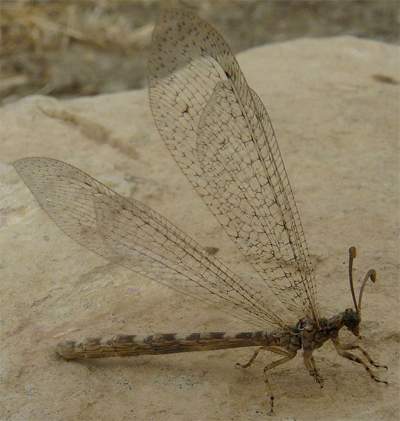
Foto della Creta: Paul Fontaine |
 |
|
|
Cmb
Moderatore
    

Città: Buers
Prov.: Estero
Regione: Austria

12844 Messaggi
Flora e Fauna |
|
|
Cmb
Moderatore
    

Città: Buers
Prov.: Estero
Regione: Austria

12844 Messaggi
Flora e Fauna |
|
|
Cmb
Moderatore
    

Città: Buers
Prov.: Estero
Regione: Austria

12844 Messaggi
Flora e Fauna |
 Inserito il - 13 novembre 2012 : 07:40:49 Inserito il - 13 novembre 2012 : 07:40:49


|
Creoleon Tillyard 1918
Roberto A. Pantaleoni: la tassonomia dei Creoleon mediterranei è ben lontana dall'essere accettabile. Speriamo che nei prossimi trent'anni si abbia il tempo di metterci mano.
Agostino Letardi: Resta valida la questione della problematicità del genere Creoleon che forse mal si presta ad essere riassunta in modo generico... forse potrebbe essere utile premettere al genere il fatto che la sistematica di questo genere (e quindi anche la sua distribuzione in Italia) deve essere rivista con molta attenzione e che certi dati "storici" possono essere dovuti ad interpretazioni imprecise e, alla luce di quanto si sa' oggi, inaccurate.
| Hölzel, H. 1976: REVISION DER EUROPÄISCHEN CREOLEON-ARTEN (PLANIPENNIA, MYRMELEONIDAE). - Zeitschr. Arb. Gem. Österr. Ent. 28(1/3).
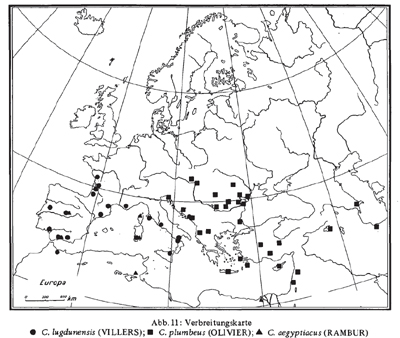
|
Creoleon aegyptiacus (Rambur 1842) (Si, Sa)
Nota di Pantaleoni R. & M. Principi nella checklist: Presente nelle Isole Pelagie (Lampedusa e Linosa) e, probabilmente con un taxon separato, in Sicilia.
Secondo Plant & Schembri (1996) anche in Malta.
Creoleon corsicus (Hagen 1860) (S, Sa)
Nota di Pantaleoni R. & M. Principi nella checklist: Endemita sardo-corso presente in S solo nell'Arcipelago Toscano (Isole di Capraia e, dubitativamente, Pianosa e Giglio).

Foto: Salvatore Canu
Creoleon griseus (Klug 1834) (Si)
Nota di Pantaleoni R. & M. Principi nella checklist: Nota solo di Lampedusa (Isole Pelagie).
Creoleon lugdunensis (Villers 1789) (S, Si, Sa)
Nota di Pantaleoni R. & M. Principi nella checklist: Presente lungo le coste tirreniche e ioniche della penisola. Vi sono dubbi sull'effettiva appartenenza a questo taxon degli esemplari sardi.
Agostino Letardi: W-Mediterraneo, con estensione alle coste europee dell’Atlantico e alla Croazia.
Distribuzione in Italia: Toscana, Lazio, Campania, Puglia, Basilicata, Calabria, Sicilia, Sardegna (Letardi 2005a). Secondo Plant & Schembri (1996) anche in Malta.
Note: Le immagini vengono raccolte quasi esclusivamente in prati incolti, estremamente secchi. Le larve si sviluppano fra i detriti ai piedi di alberi, arbusti e (forse in prevalenza) piante erbacee. Le larve non sono scavatrici e cacciano alla posta celate sotto un leggero strato di terreno nelle aree scoperte, e sembrano frequentare, piuttosto che le dune vive prossime al mare, gli ambienti retrodunali e le paleodune più interne. Periodo di volo tra maggio e agosto.
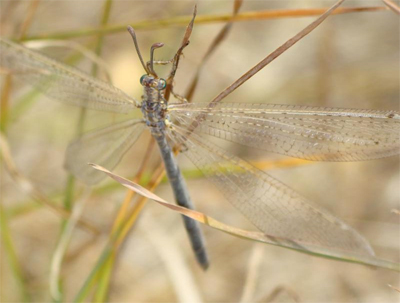
Foto della Algarve: Valter Jacinto
Creoleon plumbeus (Olivier 1811) (N, S)
Nota di Pantaleoni R. & M. Principi nella checklist: Presente lungo le coste adriatiche e ioniche della penisola. Secondo Plant & Schembri (1996) non in Malta.
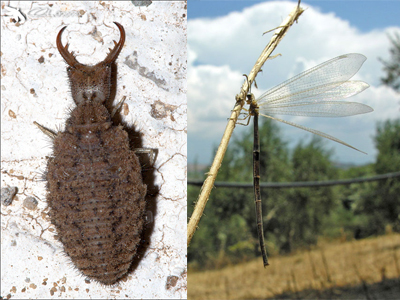
Foto della larva da Claudio Labriola e del imago della Grecia di Luca Corradi
|
 |
|
|
Cmb
Moderatore
    

Città: Buers
Prov.: Estero
Regione: Austria

12844 Messaggi
Flora e Fauna |
|
|
Cmb
Moderatore
    

Città: Buers
Prov.: Estero
Regione: Austria

12844 Messaggi
Flora e Fauna |
|
|
Cmb
Moderatore
    

Città: Buers
Prov.: Estero
Regione: Austria

12844 Messaggi
Flora e Fauna |
 Inserito il - 05 febbraio 2014 : 19:28:11 Inserito il - 05 febbraio 2014 : 19:28:11


|
nuova letteratura:
Aldini R.N., Letardi A. & R.A. Pantaleoni 2012: State of the art on Neuropterida in Sicily and Malta - Biodiversity Journal 445-458.
Badano D. & R. A. Pantaleoni 2014: The larvae of European Myrmeleontidae (Neuroptera). - 3762/1(2014): 1-71. ISSN 1175-5334 (Online Edition)
|
"Good people don't go into government" (D. Trump)

Link - nothing is more dangerous than the truth - solo chi conosce il passato, può capire il presente! - nothing is more dangerous than the truth - solo chi conosce il passato, può capire il presente!
|
 |
|
| |
 Discussione Discussione  |
|
|
|
 Natura Mediterraneo Natura Mediterraneo |
© 2003-2024 Natura Mediterraneo |
 |
|
Leps.it | Herp.it | Lynkos.net
|

 Forum
|
Registrati
|
Msg attivi
|
Msg Recenti
|
Msg Pvt
|
Utenti
|
Galleria |
Map |
Forum
|
Registrati
|
Msg attivi
|
Msg Recenti
|
Msg Pvt
|
Utenti
|
Galleria |
Map |